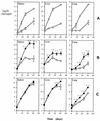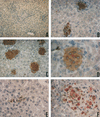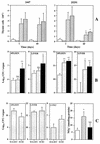Resistance of virulent Mycobacterium avium to gamma interferon-mediated antimicrobial activity suggests additional signals for induction of mycobacteriostasis
- PMID: 10377146
- PMCID: PMC116551
- DOI: 10.1128/IAI.67.7.3610-3618.1999
Resistance of virulent Mycobacterium avium to gamma interferon-mediated antimicrobial activity suggests additional signals for induction of mycobacteriostasis
Abstract
The cytokine gamma interferon (IFN-gamma) plays a major role in the control of Mycobacterium avium infections. We assessed whether the progressive growth of virulent strains of M. avium was associated with alterations in the production of this cytokine as evaluated by reverse transcription-PCR and detection of immunoreactive cytokine in the serum and in spleen homogenates. We found that IFN-gamma was induced during infection by a virulent strain of M. avium to similar or even higher extents than the levels found during infections by a less virulent strain whose growth was controlled. IFN-gamma produced during infection by both mycobacterial strains was partly derived from T cells and led to activation of macrophages, namely, those that were infected. Concomitant with the development of the infection with the virulent strain of M. avium there was an extensive depletion of lymphocytes in the spleen. Thymectomy alone promoted the proliferation of the virulent, but not of the less virulent, strain of M. avium. Our data indicate that virulent strains of M. avium resist the antimicrobial mechanisms of IFN-gamma-activated macrophages and raise the possibility that a second, T-cell-dependent signal is required for the effective control of mycobacterial replication inside macrophages.
Figures






Similar articles
-
Induction and expression of protective T cells during Mycobacterium avium infections in mice.Clin Exp Immunol. 1992 Mar;87(3):379-85. doi: 10.1111/j.1365-2249.1992.tb03006.x. Clin Exp Immunol. 1992. PMID: 1544223 Free PMC article.
-
Characterization of immune responses during infection with Mycobacterium avium strains 100, 101 and the recently sequenced 104.Immunol Cell Biol. 2002 Dec;80(6):544-9. doi: 10.1046/j.1440-1711.2002.01121.x. Immunol Cell Biol. 2002. PMID: 12406388
-
The relative impact of bacterial virulence and host genetic background on cytokine expression during Mycobacterium avium infection of mice.Immunology. 1995 Aug;85(4):556-61. Immunology. 1995. PMID: 7558149 Free PMC article.
-
Pathogenesis of Mycobacterium avium infection: typical responses to an atypical mycobacterium?Immunol Res. 2006;35(3):179-90. doi: 10.1385/IR:35:3:179. Immunol Res. 2006. PMID: 17172645 Review.
-
Protective role of interferon gamma, tumor necrosis factor alpha and interleukin-6 in Mycobacterium tuberculosis and M. avium infections.Immunobiology. 1994 Oct;191(4-5):520-5. doi: 10.1016/S0171-2985(11)80458-4. Immunobiology. 1994. PMID: 7713566 Review.
Cited by
-
Preclinical Models of Nontuberculous Mycobacteria Infection for Early Drug Discovery and Vaccine Research.Pathogens. 2020 Aug 6;9(8):641. doi: 10.3390/pathogens9080641. Pathogens. 2020. PMID: 32781698 Free PMC article. Review.
-
The Warburg effect in mycobacterial granulomas is dependent on the recruitment and activation of macrophages by interferon-γ.Immunology. 2015 Aug;145(4):498-507. doi: 10.1111/imm.12464. Epub 2015 Apr 20. Immunology. 2015. PMID: 25807843 Free PMC article.
-
Interleukin-12 primes CD4+ T cells for interferon-gamma production and protective immunity during Mycobacterium avium infection.Immunology. 2001 Jul;103(3):368-74. doi: 10.1046/j.1365-2567.2001.01237.x. Immunology. 2001. PMID: 11454066 Free PMC article.
-
IFNγ and iNOS-Mediated Alterations in the Bone Marrow and Thymus and Its Impact on Mycobacterium avium-Induced Thymic Atrophy.Front Immunol. 2021 Dec 20;12:696415. doi: 10.3389/fimmu.2021.696415. eCollection 2021. Front Immunol. 2021. PMID: 34987496 Free PMC article.
-
Nitric oxide inhibits the accumulation of CD4+CD44hiTbet+CD69lo T cells in mycobacterial infection.Eur J Immunol. 2012 Dec;42(12):3267-79. doi: 10.1002/eji.201142158. Epub 2012 Sep 26. Eur J Immunol. 2012. PMID: 22890814 Free PMC article.
References
Publication types
MeSH terms
Substances
Grants and funding
LinkOut - more resources
Full Text Sources
Medical
Molecular Biology Databases

